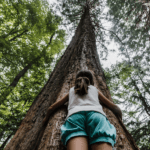
The sylvotherapy, a Japanese birth bringing man closer to nature

If you like nature and contact, this article is made for you! You can now hug nature. Originating from Japan, sylvotherapy consists in getting closer to a tree and hugging it to improve health and reduce stress. We tell you all about this little-known alternative medicine. Discover the benefits of sylvotherapy now!

Sylvotherapy, contact with nature
Sylvotherapy is a therapy characterized by close contact with the trunk of a tree. It consists of holding your breath and cuddling the trees for about 20 minutes. Beyond this aspect, forest therapy also includes all kinds of interactions aimed at well-being in the forest, starting with a good hike.
Based on the physical connection between humans and nature (especially forests), forest therapy aims to improve our well-being. Below is a non-exhaustive list of claimed benefits.
– Reduced anxiety.
– Strengthens the immune system.
– Fights depression.
– Improves blood pressure.
– Fights dementia and memory loss.
In a sedentary world where many workers are immobile all day, tied up in desks or in front of screens, it is sometimes good to seek a connection with nature and trees. The Anglo-Saxons call it a “tree hugger”. Sylvotherapy offers many benefits such as relaxation, better breathing and an increase in vitamins B and C.
A training adapted to well-being
By following the appropriate training, you can become a sylvotherapy coach. This training usually ends with a certificate. The training is of the highest quality and is inspired by Japanese sylvotherapy and recent research on the subject.
Beware, sylvotherapy is not a recognized science, but an alternative medicine and is not regulated. You can find many scams online, so take your time and check the reliability of the site.

Origin of sylvotherapy
Since ancient times, trees have been considered good for health. Many substances from the forest were used for healing in the Middle Ages. In the 1930s, sylvotherapy was used for balneotherapy. The formal origins of the practice date back to 1982, when the Forest Service included forest bathing (equivalent to forest therapy) in its recommendations for healthy living.
In France, this alternative medicine really took off in 2012 when Dr. Qing Li and his colleagues officially founded sylvotherapy (forest medicine). Today, there are more than 50 marked hiking trails in Japan where one can practice this practice under medical or academic supervision.
Prevention of certain trees
In 2014, the National Research Safety Institute (INRS) published a very large study on the allergens released by each tree to ensure your safety. Indeed, dermatologists have identified many cases of dermatitis or severe reactions after contact with certain trees. In particular, walking wasps and caterpillars can harm humans. So be careful when you are snuggling up to trees: Hide!
To find all our news, find us on Instagram and on our Twitter account.
We publish daily on our social networks so that you can be up to date every day. You can also share our content on your own networks from the options at the bottom of the page!
See the article on NEBIA: THE SHOWER THAT SAVES 75% OF WATER!
The preservation of clean water and access to it for all is at the heart of Less Saves The Planet’s commitments. You can now read Chapter 4 SAVING WATER AND THE EARTH from our book Less Saves The Planet available for free. The entire book is also available on our website.
See you soon for our next article!



















